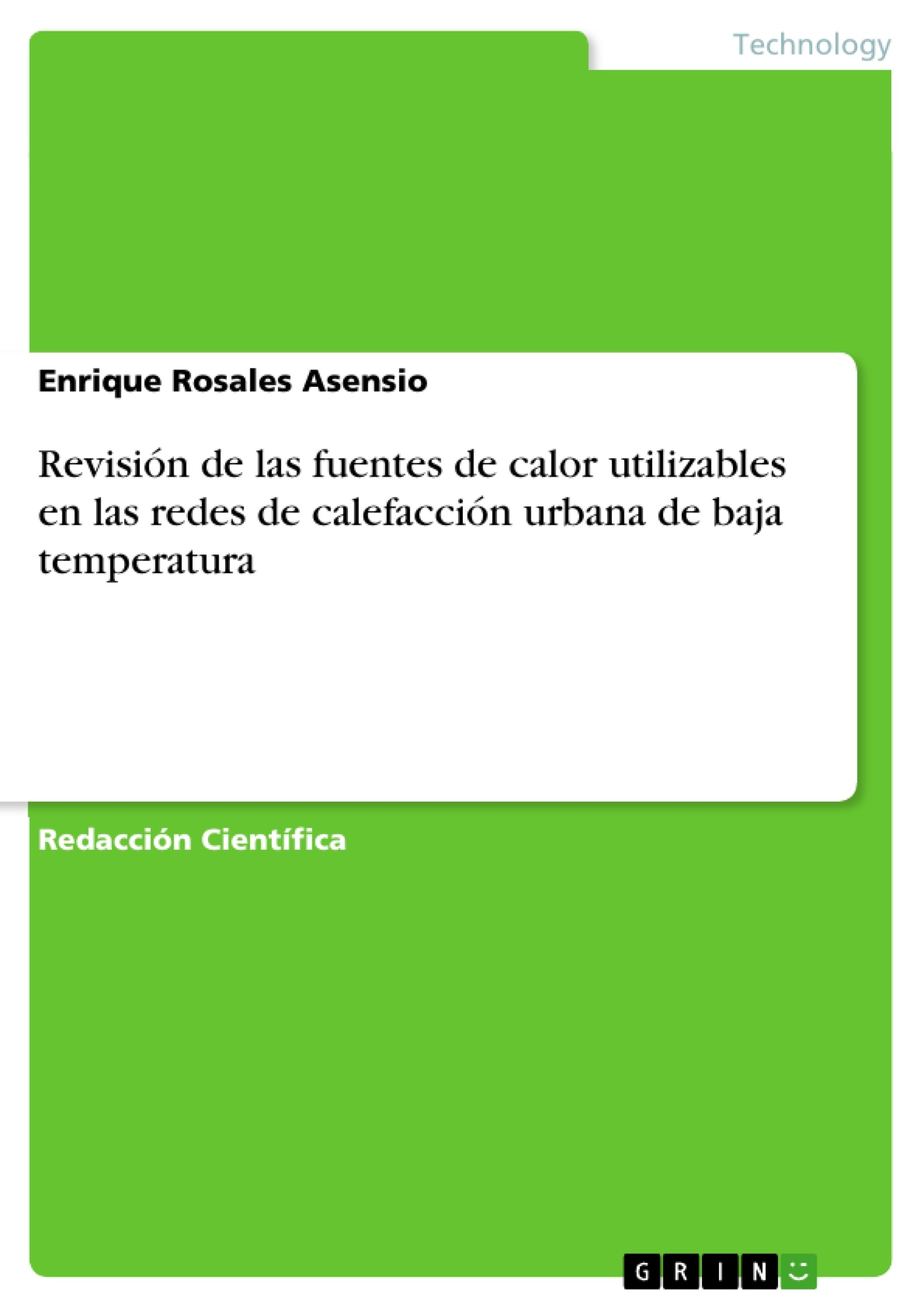En esta revisión se discutirán la mayoría de las fuentes de calor disponibles para implementar una red de calefacción urbana, haciendo mención al calor residual procedente de las centrales eléctricas (incluyendo centrales nucleares), calor obtenido a través de energía solar, calor excedente de las industrias, bombas de calor, motores de gas, calderas, incinedadoras de residuos y calderas de biomasa. Ninguna de estas fuentes de calor son excluyentes entre sí, pudiéndose considerar las mismas como complementarias en la implementación de una red de calefacción urbana.
Se discutirá el almacenamiento de calor en grandes tanques de agua (ésta es una práctica habitual en muchos esquemas de calefacción urbana). Su uso posibilita la absorción de la energía eólica sobrante a través de bombas de calor o a través de una resistencia calefactora y su posterior transporte a los clientes a través de tuberías. Además, dicho almacenamiento posibilita también que la planta de cogeneración genere durante períodos de escasez de viento y almacene el calor residual hasta que sea necesario, maximizándose de este modo los beneficios económicos.
Es preciso indicar que los costes del almacenamiento térmico es claramente inferior a los que se incurrirían con una central hidroeléctrica reversible y que un almacenamiento masivo (con el objeto de suministrar la energía eléctrica almacenada a los consumidores) implicaría una inversión significativa en la actualización de la red eléctrica de distribución, no siendo éste el caso para la electricidad que se almacene en forma de calor en acumuladores térmicos.
Finalmente se analizará la tecnología de refrigeración urbana y cómo ésta puede formar parte de un sistema de calefacción urbana, discutiéndose por otra parte cómo se puede transmitir el frío/calor y los probables costes incurridos en el transporte y almacenamiento del mismo.
Inhaltsverzeichnis
- EINLEITUNG
- VERFÜGBARE WÄRMEQUELLEN FÜR DIE FERNWÄRME
- AKTUELLE WÄRMEQUELLEN FÜR FERNWÄRME IN DER EUROPÄISCHEN UNION
- INDUSTRIEABWÄRME
- SOLARE FERNWÄRME
- WÄRME AUS GEOTHERMISCHER ENERGIE
- HILFSMESSER
- BIOMASSEKESSEl
- KWK MIT KLEINEN GASMOTOREN
- GROSSE WÄRMEPUMPEN FÜR FERNWÄRME
- ABWÄRME AUS KERNKRAFTWERKEN
- GEMEINSAME NUTZUNG VERSCHIEDENER WÄRMEQUELLEN
- WÄRME SPEICHERUNG IN SPEICHERN IN FERNWÄRMESYSTEMEN
- ELEKTRISCHE SPEICHERUNG UND WÄRME SPEICHERUNG
- VORTEILE DER WÄRME SPEICHERUNG IM BETRIEB VON KWK-ANLAGEN
- DIAGRAMME DER VERBINDUNG DER WÄRME SPEICHERUNG IN FERNWÄRMENETZEN
- STADTKÜHLUNG
- EINLEITUNG
- FREIE KÜHLSYSTEME
- KOMPRESSORKÜHLUNG
- ABSORPTIONSKÜHLUNG
- VERGLEICH DER KOSTEN VON KOMPRESSORKÜHLUNG UND ABSORPTIONSKÜHLUNG
- TRIGENERAION
- TECHNOLOGIE DES GROSSEN WÄRMETRANSPORTS
- WÄRMEVERTEILUNG IN MODERNEN FERNWÄRMESYSTEMEN
- LASTPROFILE UND DIMENSIONIERUNG VON KWK-ANLAGEN
- TYPISCHES LASTPROFIL FÜR FERNWÄRMESYSTEME
- DIMENSIONIERUNG VON KWK-SYSTEMEN UND IHRE EIGNUNG IN FERNWÄRMENETZEN IN DER EUROPÄISCHEN UNION
- FAZIT
Zielsetzung und Themenschwerpunkte
Die vorliegende Arbeit befasst sich mit der Analyse verschiedener Wärmequellen, die für den Betrieb von Niedertemperatur-Fernwärmesystemen in der Europäischen Union relevant sind. Das Ziel ist es, einen umfassenden Überblick über die verfügbaren Optionen zu geben, ihre Vor- und Nachteile zu beleuchten und die bestmöglichen Praktiken für die Implementierung und den Betrieb von Fernwärmesystemen aufzuzeigen.
- Bewertung verschiedener Wärmequellen für Fernwärmesysteme
- Analyse der Einsatzmöglichkeiten von Industrie- und Abfallwärme
- Untersuchung der Rolle von erneuerbaren Energien wie Solarenergie und Geothermie
- Bewertung von Wärme- und Kältespeichertechnologien für Fernwärmesysteme
- Diskussion der Möglichkeiten der Stadtkühlung im Zusammenhang mit Fernwärmesystemen
Zusammenfassung der Kapitel
Die Arbeit beginnt mit einer Einführung in die Bedeutung von Fernwärmesystemen für die Steigerung der Energieeffizienz und die Reduzierung von CO2-Emissionen. Anschließend werden verschiedene Wärmequellen, die für den Betrieb von Fernwärmesystemen in der Europäischen Union zur Verfügung stehen, vorgestellt. Die Analyse umfasst sowohl konventionelle Wärmequellen wie Kohle- und Gaskraftwerke als auch erneuerbare Quellen wie Solarenergie, Geothermie und Biomasse.
Ein weiterer wichtiger Aspekt ist die Betrachtung der Wärme- und Kältespeicherung in Fernwärmesystemen. Die Arbeit geht auf die Vorteile der Speicherung ein, die Möglichkeiten der Integration von Speichertechnologien in Fernwärmesysteme und die verschiedenen Speicherformen wie Wasser-, Eis- und Salzschmelzespeicher.
Schließlich wird die Technologie des Wärmetransports und die Verteilung von Wärme in modernen Fernwärmesystemen diskutiert. Die Arbeit beleuchtet die verschiedenen Möglichkeiten des Wärmetransports, die Bedeutung von Wärmedämmung und die Herausforderungen bei der Optimierung von Fernwärmesystemen.
Schlüsselwörter
Fernwärme, Wärmequellen, Niedertemperatur-Fernwärme, Wärmetransport, Wärmeverteilung, Wärme- und Kältespeicher, erneuerbare Energien, Solarenergie, Geothermie, Biomasse, Industrie- und Abfallwärme, Stadtkühlung.
- Quote paper
- Enrique Rosales Asensio (Author), 2015, Revisión de las fuentes de calor utilizables en las redes de calefacción urbana de baja temperatura, Munich, GRIN Verlag, https://www.hausarbeiten.de/document/303353


